Two New Ions: ASUS AT3N7A-I and ASRock Ion 330
by Anand Lal Shimpi on August 28, 2009 12:00 AM EST- Posted in
- Motherboards
Determining the Speed of an Atom
In case you missed it, I’m providing some comparison numbers between the ASUS Ion and the systems I tested in the Zotac Ion review. This accomplishes two things: 1) it shows you that the ASUS Ion performs identically to the Zotac Ion, and 2) it puts the Atom 330’s performance in perspective compared to other non-Atom based platforms. If you want more detail on how the Atom 330 compares to an older platform like a Pentium 4, check out the Zotac review.
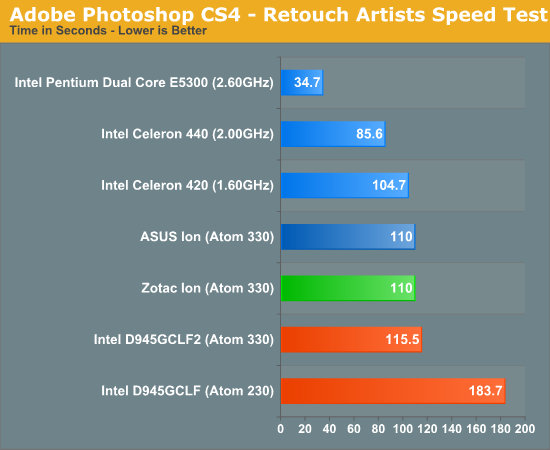
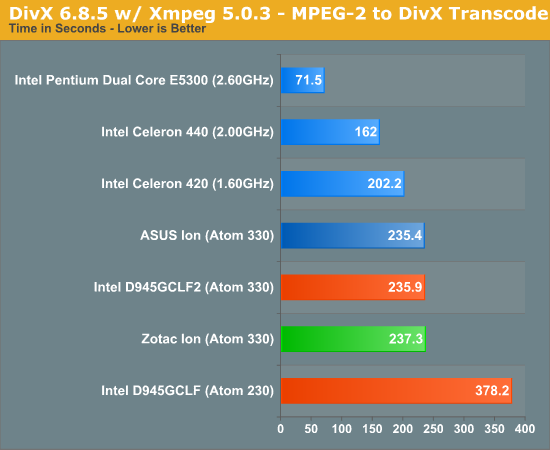
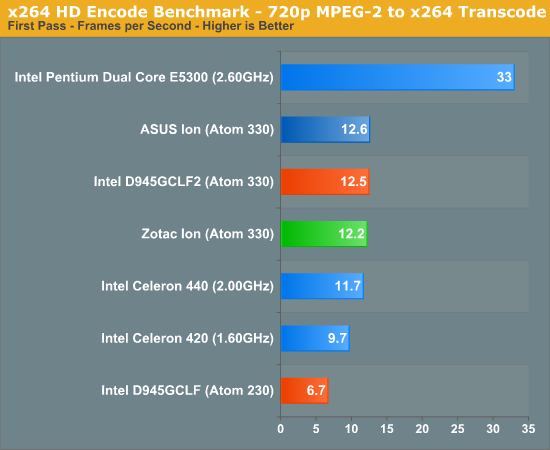
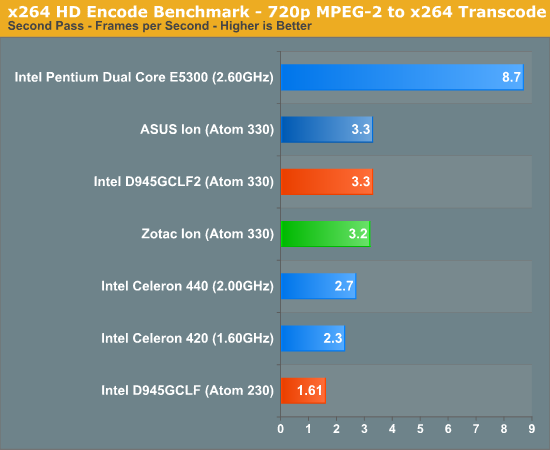
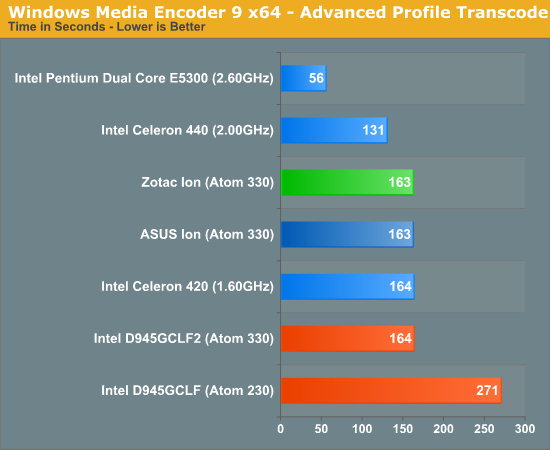
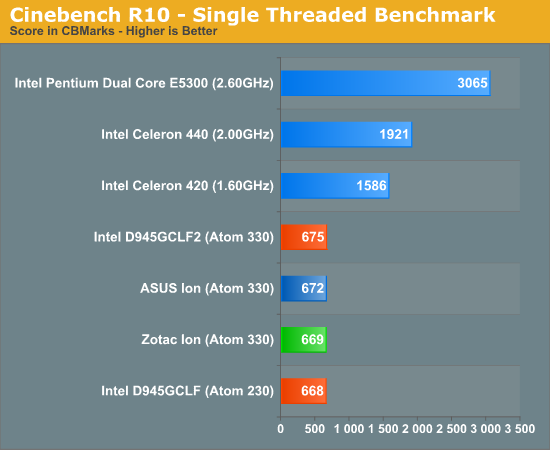
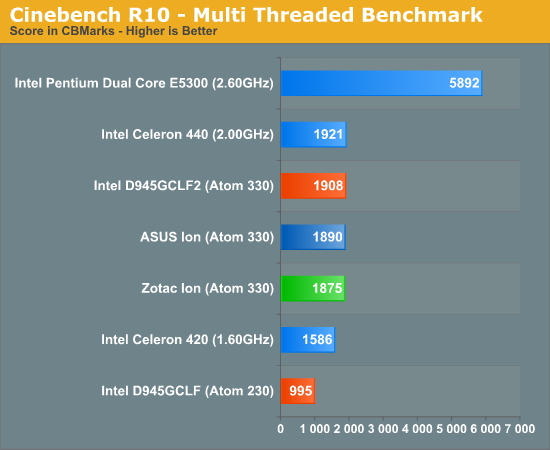
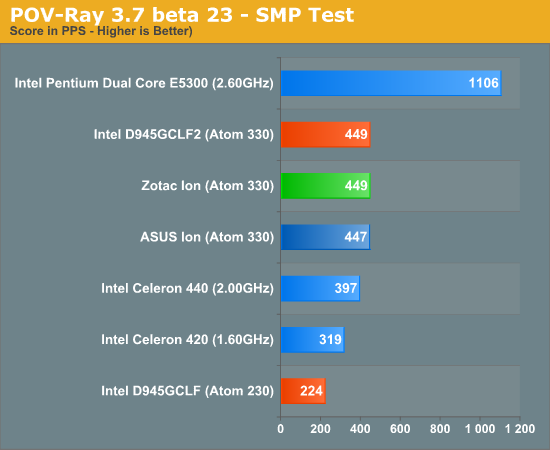

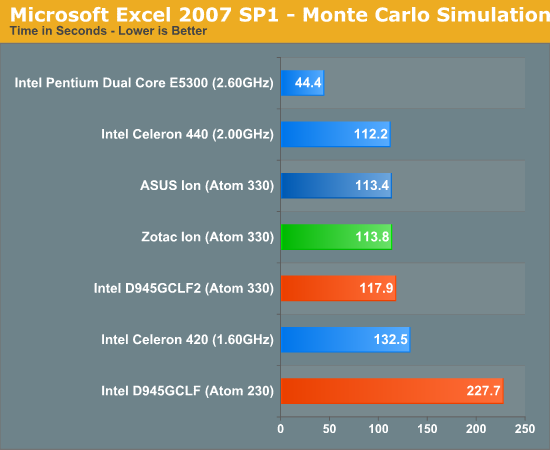

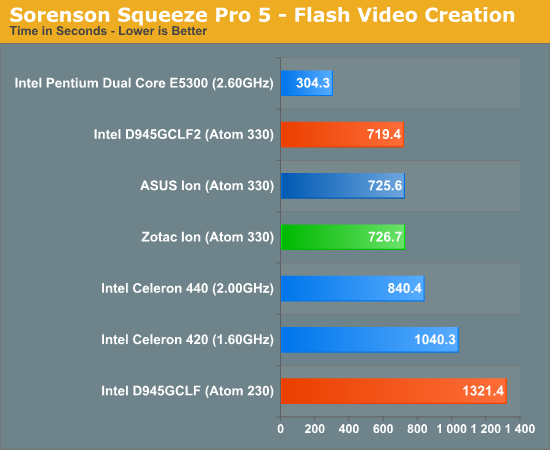
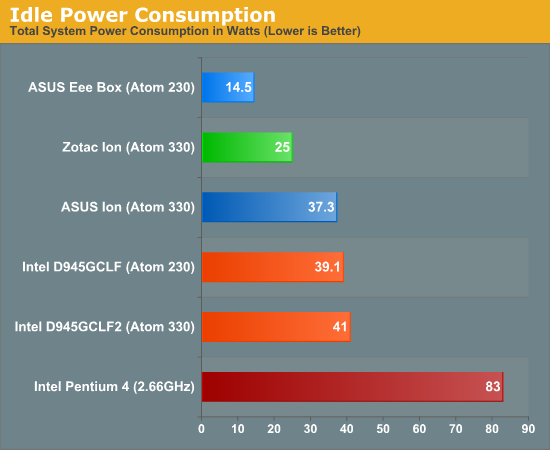
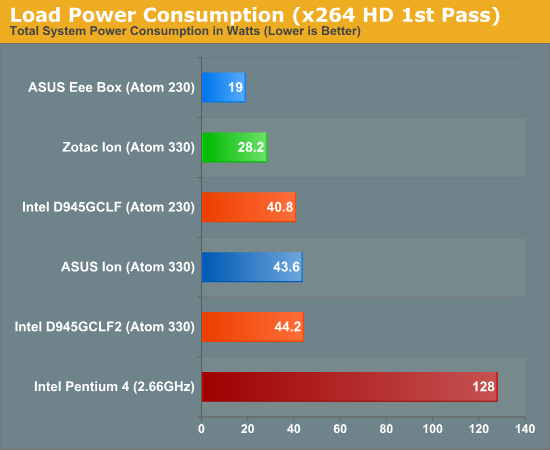
Gaming and CUDA Performance
I already went through this in the Zotac review, allow me to quote:
The gaming performance of Intel’s basic Atom platform is a joke. I’ll put aside debates of whether or not you would want to game on an Atom for a moment. World of Warcraft does a great job of straddling the line between casual and hardcore gaming and thus makes a good candidate for looking at gaming performance of Ion vs. Intel’s standard Atom platform.
I tested by running through a small outdoor section at 800 x 600 (24-bit color, no AA) using WoW’s built in “Good” visual quality settings. This is the same chart from the Pentium 4 section but I'm repeating it here so you have something to look at while we discuss the gaming potential of Ion:
The Ion platform managed just under 18 fps, which wasn’t incredibly smooth to play on but it was close. If I dropped the settings even lower I could easily get a smooth experience. The Intel D945GCLF2 managed a whopping 3 fps. I didn’t even bother benchmarking the single core version; I’m not that fond of single digits.
Most modern FPS games will show worse performance than what we just saw under WoW. Far Cry 2 and Crysis Warhead will give you under 7 fps for Zotac’s Ion platform, but other, more mainstream titles will perform similarly if not better.
I still maintain that the Atom CPU is not fast enough for a good gaming experience on far too many modern titles, but to NVIDIA’s credit, the Ion platform does make it fast enough in games that it otherwise wouldn’t be.
CUDA performance is a bit similar. The GPU can definitely help Atom in some situations if there's proper support, but don't expect to really ever make an Ion "fast" by today's standards. Gary had a particularly great experience with transcoding using Cyberlink's Media Espresso. Using one of our standard transcoding test files Gary made a high quality YouTube video with just the Atom 330 CPU in 405 seconds. Turning on GPU acceleration dropped the time to 261 seconds.
Overclocking the CPU to 2GHz brought the encode time down to 318 seconds; doing the same to the GPU (600MHz core, 1.4GHz shader clock) and turning on CUDA support brought the total time down to 203 seconds.


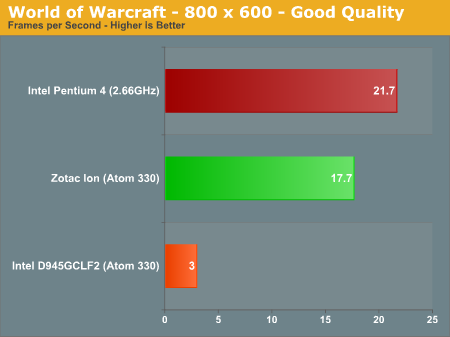








61 Comments
View All Comments
jwinckelmann - Sunday, September 13, 2009 - link
Hi,at least here in Germany the AT3N7A-I is officially sold with the noisy 6000 RPM fan. Totally unacceptable...
Bye,
Jan
nachtgeist - Sunday, September 6, 2009 - link
Very usefull rewiev, but i don't understand where is diffenrent between Asus and Zotac board for the 20% power consum diffenrent.Asus Express gate looks very good. But the power consum and noise fan is terrible.
When is poblem? Same CPU, same Chipsets and Asus takes 19W(?) more.
Abby - Wednesday, September 2, 2009 - link
A thousand Thaanks on effort writing this article and all the troubleshooting and also all the great help on sending bck faulty reports on behalf of us.Your enthusiasm on technology and service were greatly appreciated.
Thanks again.
best regards,
Abby
THG S**Ks hard~!
Shadowmaster625 - Tuesday, September 1, 2009 - link
Why not just use a celeron E1400 for $40, and maybe even overclock it?And yes, I would still trust my $50 ebay P4 865g system over one of these things. 166MHz FSB isnt just stupid, its like a sick joke.
deegee - Tuesday, September 1, 2009 - link
> Why not just use a celeron E1400The Atom CPU's lower power is the point of these.
You can also purchase the ITX boards with socket LGA775 or AM2 if you want a faster processor, but at a major increase in power use.
> I would still trust my $50 ebay P4
Trust? These are the same components as found on ATX boards, just a smaller form factor at 17cm x 17cm. ITX is designed for smaller size and lower power. Compare it to like buying a Mac Mini.
> 166MHz FSB
The Atom units are 533 FSB. Look at the "Rated FSB" value on CPUZ. The Bus Speed will be 1/2 for a two-way and 1/4 for a 4-way interleaved memory system. The regular ATX systems are the same for their FSB. You may wish to dl a copy of CPUZ and run it on your own system to see what the numbers mean.
deegee - Tuesday, September 1, 2009 - link
Sorry, fingers working faster than brain and no post edit... :-)DDR = double data rate, so 133 clock = 266 DDR freq, 2x interleave = 533 FSB, if I recall.
deegee - Tuesday, September 1, 2009 - link
I've been using an Atom PC for my surfing system for quite some time now. It has the Intel 945GCLF2D, 2GB RAM, Kingston 64GB SSDnow, in an Apex MI-008 case. On sale all the parts cost me about $300CDN. The case is 8.5"W x 12.5"D x 5"H (just slightly larger than an APC ES750W brick UPS), supports 2x 3.5" and 1x 5.25", and includes a 250W internal PS. It would work for a HS or HTPC since you could fit an SSD OS drive, a 1-2TB HD, and a DVD.I pulled the noisy fan off of the mobo and put a Noctua 80mm fan with the silencer connector (970RPM) blowing across the board from case vent-to-vent. It's so quiet you can hardly tell the system is on (it's half as loud as just a 3.5" HD's noise). The CPU runs at 25C, mobo at 40C. Temps go up by only ~5C under full load in Everest etc.
I'm running Windows 7RC and Kubuntu on it. Ubuntu (Gnome) is just too slow on the video. KDE performs not bad. But W7RC in Aero performs well, even on the GMA950. It is not as fast as my C2D or C2Q workstations of course, but it does ok for surfing. I also have a HS and HTPC but both of those are using C2D ATX, I personally wouldn't use an Atom for those since I prefer more performance, but for general surfing and a low-power system that I can leave on for downloading I don't care.
I'll probably upgrade the mobo sometime in the future to get the better video. I really recommend the small size and low noise of the Atom.
lordmetroid - Monday, August 31, 2009 - link
I want to build a server/HTPC combo, thing is it will have to be in my home and I can't get proper rest with a fan humming in the background.I was thinking, would it be possible to build a completely fanless system using the IONITX-C-U? Using an SSD and the external power brick would give me a system without any moving parts. But what kind of temperatures would such a system generate?
snarfies - Monday, August 31, 2009 - link
Asus and Asrock have repeated the exact same mistake that prevented me from considering the Zotac - Only three drive connectors. My MiniITX file server requires four: One for the SD Card reader, one for the optical drive, and two for the RAID1. The only Ion-based board that I know to support four drives is the Point of View Ion 330.strikeback03 - Monday, August 31, 2009 - link
There are USB headers that can be used for a card reader